The OnePlus One Review
by Joshua Ho on November 19, 2014 8:00 AM EST- Posted in
- Smartphones
- Android
- Mobile
- OnePlus
Battery Life
At this point, battery life is one of the number one priorities for a phone. While in 2013 our primary tests consisted of the web browsing test and video playback tests, we've expanded our suite to include Basemark OS II and GFXBench to simulate intensive general usage and gaming, respectively. For all of our tests in which the display is on, we calibrate the brightness of full white to be 200 nits in order to standardize and attempt to control for extraneous variables as much as possible. While this may seem arbitrary, it's important to do so to draw real conclusions about which phone has better battery life. 200 nits on a phone can be as low as 50% and as high as 90%, so setting a standardized brightness percentage would not be an effective method of controlling for display brightness. With that in mind, let's get to the battery life tests.

Here, we see that the OnePlus One takes the number three spot for battery life amongst phones and phablets. This is definitely a great result to start with, and is a solid 20% higher than the One (M8). However, the Huawei Ascend Mate 2 continues to hold its position with a long lead over just about anything else available in the market today.
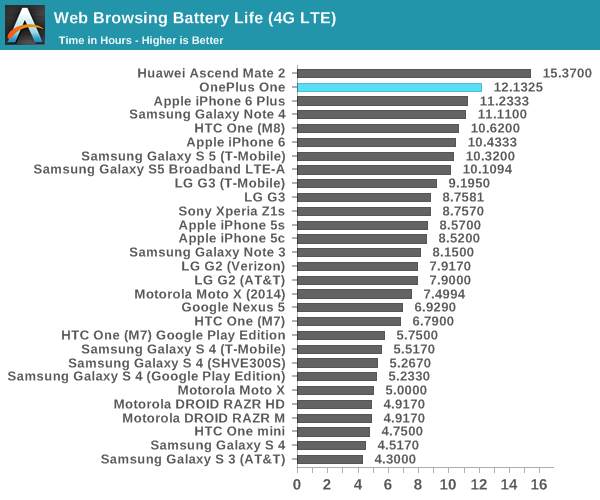
We can see a similar story in LTE web browsing battery life. However, the OnePlus One manages to close up the lead that the Ascend Mate 2 holds in WiFi browsing. It's likely that the 28nm LP process and lack of envelope tracker is responsible for closing the gap in this regard. It's interesting to see how the iPhone 6 Plus trails behind the OnePlus One here, but it's likely that this difference is due to the fact that the iPhone 6 Plus has an off-die modem compared to the OnePlus One's on-die modem.
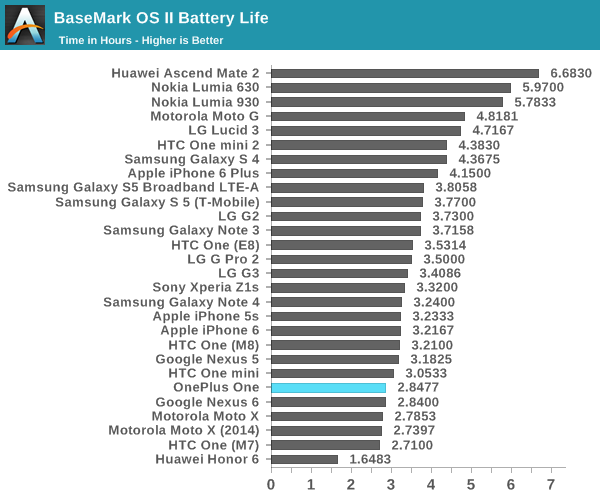

White battery life tends to fall towards the bottom here, we can see that the reality is that the OnePlus One performs quite well, which indicates that there's relatively little throttling to speak of and that the OnePlus One is simply doing well by sustaining high levels of performance.
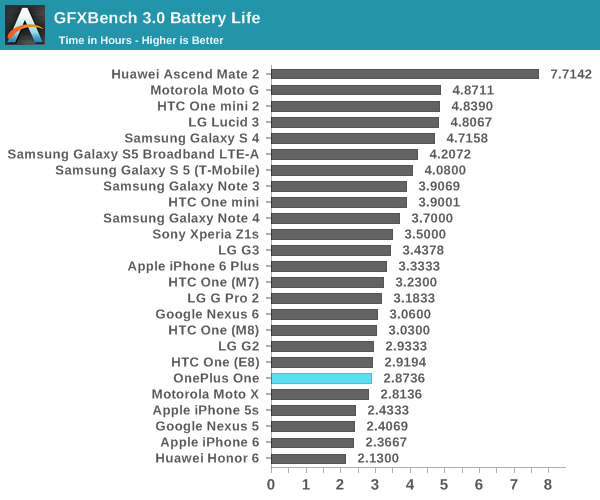
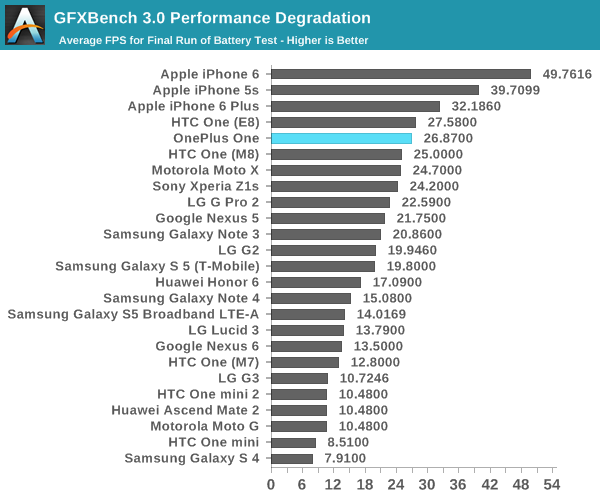
We see the same story in the GFXBench rundown. The OnePlus One manages to set a new record for final run FPS among phones and phablets, although battery life is near the bottom of the pack. It seems that if there's any one reason for the escalating display size wars, it is to increase battery life. While by no means a clear order, we can see that the larger battery more than compensates for the larger display of the OnePlus One. This makes sense, as a phone should have a fixed size circuit board. Therefore, by increasing display size the circuit boards become smaller relative to the rest of the phone, and all of the area opened up by increasing the size of the phone can be taken up by the battery. Overall, the OnePlus One is almost as good as it gets for battery life in a phone, with excellent sustained performance under load.
Charge Time
To really have a holistic understanding of battery life, we must also take a look at charge time. While battery life can be the only determinant of mobility, in cases where usage is heavy enough that the battery or multiple batteries have to be charged, charge time can become incredibly important. To this end, OnePlus includes a 5V, 2.1A charger in the box to quickly charge the rather large 11.78 WHr battery.
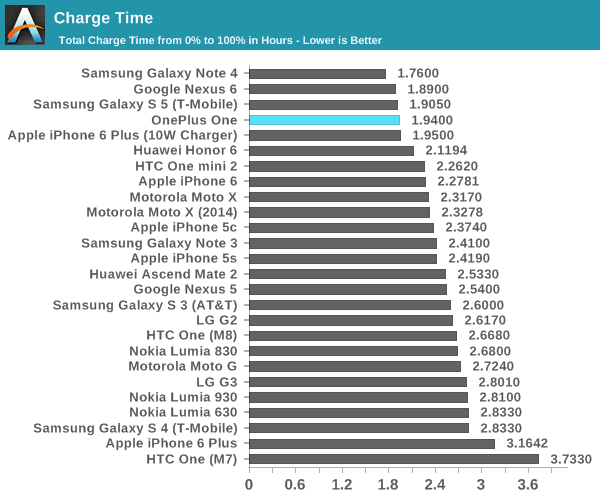
Somewhat surprisingly, the OnePlus One does a great job in this test, coming quite close to other devices with QC 2.0 fast chargers like the Galaxy Note 4 which is definitely good to see. Overall, this makes the OnePlus One one of the best phablets on the market for battery life.










148 Comments
View All Comments
tipoo - Wednesday, November 19, 2014 - link
Was that meant as a reply to me? I know that, the N5 was a great example of this. Though the 6 is going back up to stupid pricing.tipoo - Wednesday, November 19, 2014 - link
Yes the authors "first" comment was wrong, but I meant about the "understand the market" bit, I'm guessing he means subsidized prices.Arbie - Wednesday, November 19, 2014 - link
A phablet with no microSD? These larger phones (and of course tablets) are what benefit from that the most, in their role as media players. I wouldn't even consider the OPO.coldpower27 - Wednesday, November 19, 2014 - link
64GB is already sufficiently large that a microSD isn't totally necessary. Less and less Android phones have this feature now. That has been the general trend now. Google is moving away from it with the Nexus 5/6/9, Apple never has had it in it's products.There are still some modern products that have it. Samsung GS5, Note 4, HTC One M8, LG G3.
cjs150 - Wednesday, November 19, 2014 - link
The idea that 64 G is enough is hilarious - this is a phone begging to be used as a media device whilst travelling. The reason for removing the microSD is a function of price. Phone/Tablet manufacturers massively overcharge for adding extra storage. It is also a function of the same manufacturers employing designers who, to put it simply, need to get out into the sunshine a bit more. Not everywhere has good access to the cloud, in fact huge chunks of the first world has poor or no access - and that is before you get started on the data cap that no doubt is written into your phone contractChaser - Wednesday, November 19, 2014 - link
What's hilarious is are people that believe 5" phone displays should be loaded up with movies and then used as miniature Imax viewers. It's a phone. It doesn't need 80 HD movies with Dolby Digital 7.1.jabber - Thursday, November 20, 2014 - link
Yeah if you are going on vacation, enjoy the vacation. Don't spend it watching crappy movies the whole time. You really don't need to carry masses of video and audio around.oliwek - Saturday, November 22, 2014 - link
Those recent phones have (micro)-USB OTG connectors. So it's possible to stock movies and music on USB thumb drives... I'd prefer to get the choice, though.oliwek - Saturday, November 22, 2014 - link
LG G2 had no SD card slot, G3 has got one. Same evolution for the HTC One. And Samsung flagships always had SD card slots. So this evolution is not so widespread (if you except Nexus models, and Apple tactics to let the customer pay more and more for enough NAND)..
slfisher - Monday, November 24, 2014 - link
I held off from getting a OnePlus for that reason for quite a while -- as well as the fact that it doesn't have a removable battery. I was really holding out for either a Google Play edition of the S5, or Lollipop on my existing S3. Since neither one was forthcoming, I went for the OnePlus because of the bare metal and the 64GB.